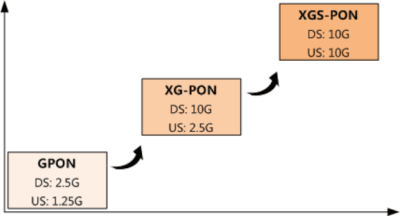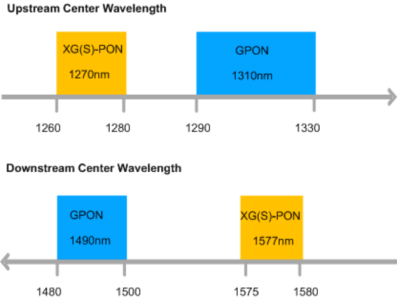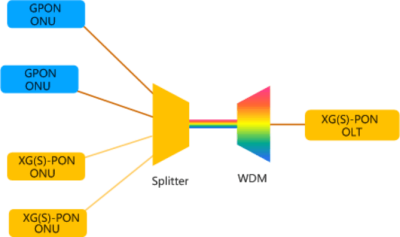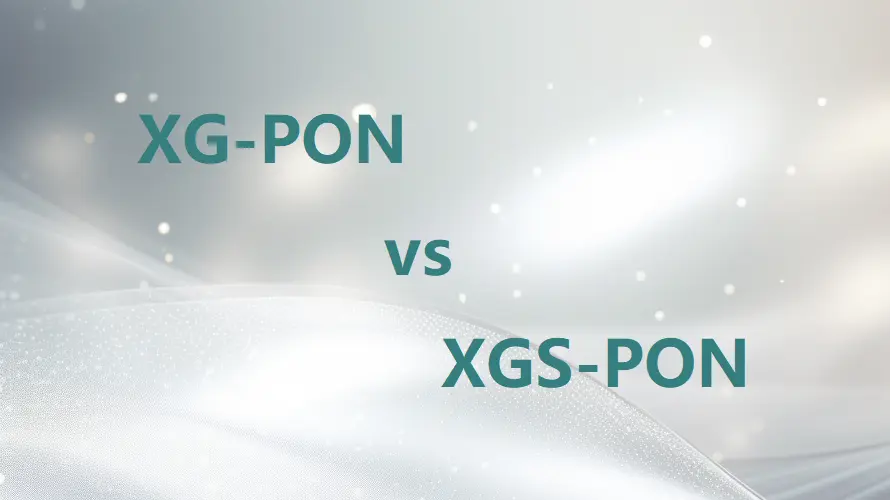What is XG(S)-PON (XG-PON and XGS-PON), Huawei XG-PON board CGHF, XGS-PON board CSHF, what are the differences?
XG(S)-PON is evolved from the existing GPON technology, XG(S)-PON technologies include XG-PON and XGS-PON.
Technology Evolution
1, GPON Technology Evolution
GPON Technology Evolution Roadmap

- XG-PON, 10-Gigabit-capable passive optical network, provides asymmetric 10G transmission (Maximum downstream line rate: 9.953 Gbit/s, Maximum upstream line rate: 2.488 Gbit/s ).
- XGS-PON, 10-Gigabit-capable symmetric passive optical network, provides symmetric 10G transmission (Maximum downstream line rate: 9.953 Gbit/s, Maximum upstream line rate: 9.953 Gbit/s ).
NOTE:
- XG-PON and XGS-PON belong to the XG(S)-PON technology. Therefore, this document describes them as XG(S)-PON. However, this document describes them specifically for their differences.
- Here only describes the technical evolution of the GPON, does not represent the current support capabilities of the product, the product capabilities please refer to the specific specifications.
2, Standard Formulation Progress
XG(S)-PON standard formulation progress

In 2004, International Telecommunication Union-Telecommunication Standardization Sector (ITU-T) Q2 started to research and analyze the possibility of evolving GPON to XG-PON.
- In September 2007, Q2 officially released the enhanced wavelength plan to standardize the coexistence of GPON and XG-PON.
- In November 2007, Q2 confirmed the XG-PON standardization roadmap. With the goal of achieving low cost, high capacity, wide coverage, full service, and high communication capability, Q2 sped up the researching and finalizing of the XG-PON standard.
- In October 009, Q2 officially released the phase 1 text for the XG-PON standard during the SG15 plenary meeting. The text contained overall requirements for XG-PON (G.987.1) and physical-layer physical media dependent (PMD) standard (G.987.2).
- In June 2010, Q2 released the convergence-layer transmission convergence (TC) standard (G.987.3) and the management-layer optical network terminal management and control interface (OMCI) standard (G.988) for XG-PON.
- In June 2012, released the XG-PON Reach extension TC layer standard (ITU-T G.987.4).
- In June 2016, released the 10-Gigabit-capable symmetric passive optical network (XGS-PON) standard (G.9807.1).
What Is XG(S)-PON?
XG(S)-PON is evolved from the existing GPON technology, the factors promoting the technology evolution to XG(S)-PON are as follows:
- Developing services require higher bandwidths and the GPON technology cannot meet bandwidth requirements.
- Innovative access technologies on the user side require higher bandwidths and the GPON technology will face bandwidth bottlenecks.
- A greater split ratio and a longer transmission distance increase network construction investments
Specification Differences Between GPON, XG-PON and XGS-PON
The following table lists specification differences between the two technologies.
NOTE:
Here only describes the technical specification of the GPON, XG-PON and XGS-PON, does not represent the current support capabilities of the product, such as Huawei MA5800 board, the product capabilities please refer to the specific specifications.
| Specification | GPON | XG(S)-PON | |
| XG-PON | XGS-PON | ||
| Wavelength | · Downstream: 1480-1500 nm
· Upstream: 1290-1330 nm |
· Downstream: 1575-1580 nm
· Upstream: 1260-1280 nm |
· Downstream: 1575-1580 nm
· Upstream: 1260-1280 nm |
| Center wavelength | · Downstream: 1490 nm
· Upstream: 1310 nm |
· Downstream: 1577 nm
· Upstream: 1270 nm |
· Downstream: 1577 nm
· Upstream: 1270 nm |
| Maximum Line Rate | · Downstream: 2.488 Gbit/s
· Upstream: 1.244 Gbit/s |
· Downstream: 9.953 Gbit/s
· Upstream: 2.488 Gbit/s |
· Downstream: 9.953 Gbit/s
· Upstream: 9.953 Gbit/s |
| Frame Structure | GEM | XGEM | XGEM |
Network Evolution Overview
For the GPON network that has been deployed on the live network, XG(S)-PON can smoothly evolve from the GPON network to the XG(S)-PON network.
Why Is Smooth Evolution Required?
The smooth evolution from the GPON network to the XG(S)-PON network is mainly due to the following reasons:
- With the development of services, the bandwidth requirement of users is gradually increasing. In the short term, only some users need to be upgraded to the XG(S)-PON network, and some users continue to use the GPON network.
- For a PON network that has been deployed on the live network of a carrier, it is costly to directly cut over the GPON network to the XG(S)-PON network. The evolution from GPON to XG(S)-PON must be completed through smooth evolution.
What are the conditions for smooth evolution from GPON to XG(S)-PON?
XG(S)-PON has the following features to support smooth evolution from a GPON network to a XG(S)-PON network:
- The XG(S)-PON wavelength planning does not overlap the GPON wavelength planning. Therefore, the GPON and XG(S)-PON share the ODN network in the wavelength division multiplexing mode.
- The OLT platform supports coexistence of GPON service boards and XG(S)-PON service boards.
- XG(S)-PON and GPON have the same service provisioning and service deployment operations. They can share the NMS and service provisioning system.
No Wavelength Overlap Between GPON and XG(S)-PON
Wavelength distribution of GPON and XG(S)-PON

XG(S)-PON Can Co-exists with GPON in the Same ODN
GPON and XG(S)-PON can coexist in the same ODN with wavelength division multiplexing (WDM Wavelength-Division Multiplexing) mode.






















